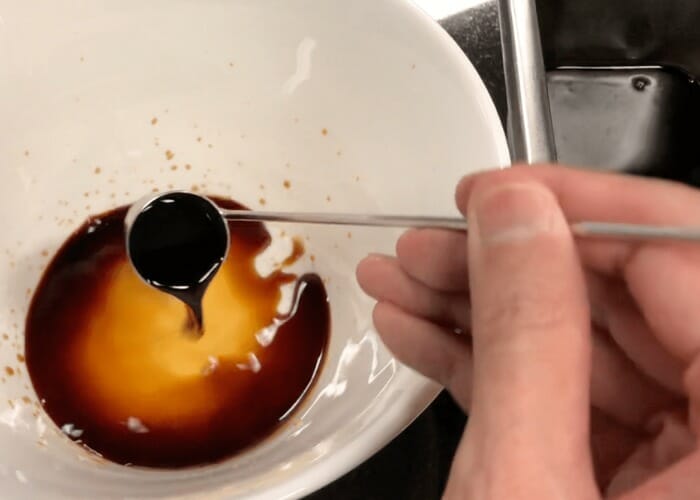I’ve always had a deep love for ramen. There’s just something so comforting about a steaming hot bowl of noodles and broth. Over the years, I’ve tried all kinds of ramen – from the instant packs to fancy restaurant bowls. But I’ve never actually attempted to make it at home.
That changed recently when I came across a Shoyu Tonkotsu Ramen recipe. As soon as I read the description of the rich, creamy pork bone broth with the tang of soy sauce, I knew I had to give it a try.
The truth is, I’ve been feeling a little down lately. The long winter months get me in a bit of a funk sometimes. I thought cooking this ramen would be the perfect pick-me-up – a little project to dive into and maybe help pull me out of my cold weather blues.
So I gathered all the ingredients and eagerly prepped my very first homemade ramen broth. I’ll admit, it took some time and effort. But as I watched that tonkotsu broth simmer and the savory aromas filled my kitchen, I could feel my spirits start to lift.
When everything finally came together in that bowl – the slice of chashu pork, the ramen noodles, that glorious broth – I took my first sip and was transported. In an instant, memories of my travels to Japan and the amazing ramen I enjoyed there came flooding back. Comfort, joy and warmth – that’s what this Shoyu Tonkotsu Ramen gave me. And suddenly this dreary winter didn’t seem so bad after all.
Shoyu Tonkotsu Ramen Recipes
Shoyu Tonkotsu Ramen is a popular type of ramen in Japan. It is a savory version of ramen that is made with pork bones and a soup base made from vegetable stock. The noodle is often thin and creamy. It is served with a variety of toppings, including meat and vegetables. The soup base is often topped with chashu pork, scallions, and sweet corn.
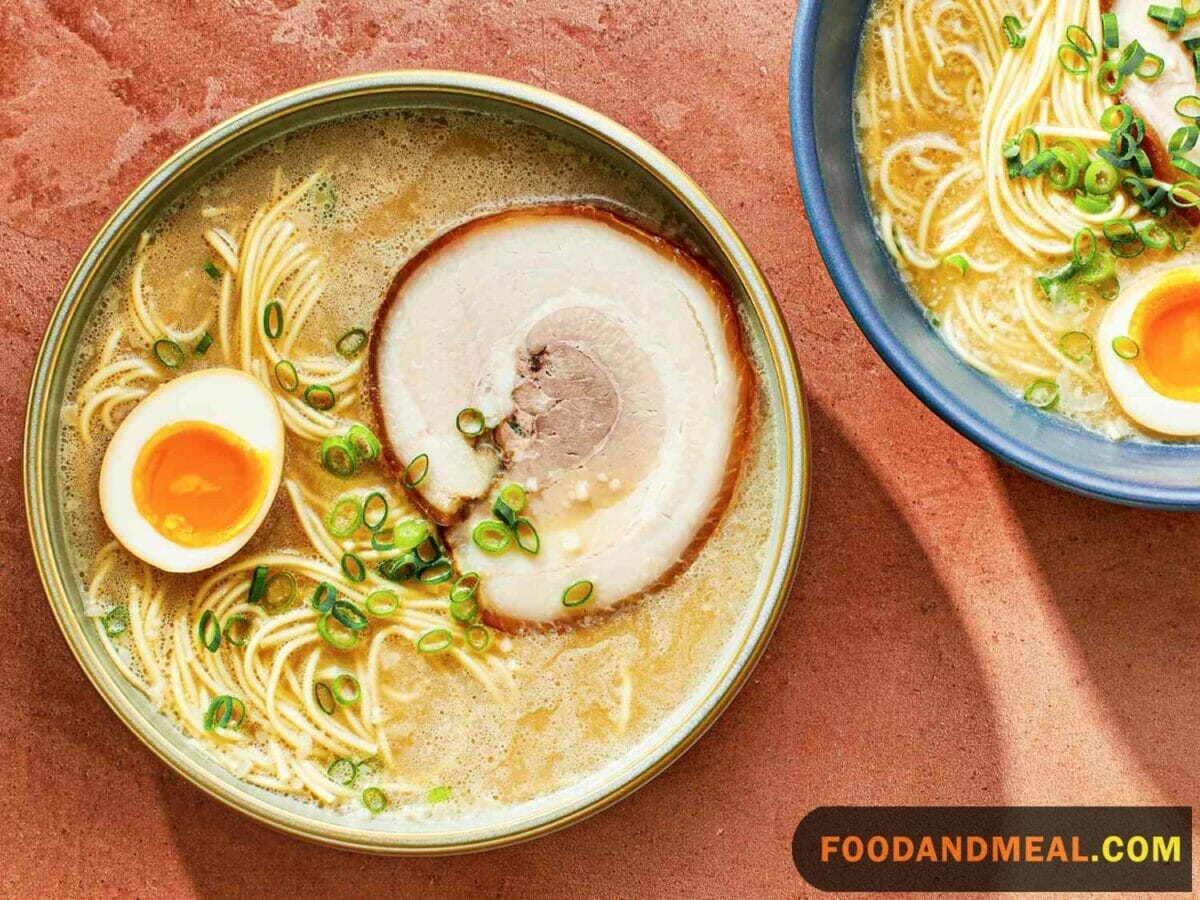
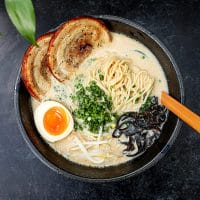
Shoyu Tonkotsu Ramen
Equipment
Ingredients
- ½ cup Shoyu Tare
- 5 cups Tonkotsu Creamy Soup
- 1⅓ pounds noodles fresh, such as thin Chukasuimen
- 4 to 8 slices Pork Chashu
- Kikurage
- Negi
Instructions
- With all your ingredients ready to go, bring a large pot of water to a boil over medium-high heat.
- Heat your ramen bowls by filling them halfway with hot water. The bowls don’t need to be scalding, but they should be hot to the touch. Dump out the hot water and dry the bowls with some paper towels or a clean towel.
- Put the tare and soup in a medium saucepan. Mix and bring to a simmer over low heat.
- Cook the noodles in the large pot of boiling water. Ramen that has been cut to a standard thickness (about 1 mm) will cook in 1 to 2 minutes.
- About 30 seconds before the noodles are finished cooking, ladle the soup into the ramen bowls.
- Drain the noodles, taking care to shake off as much excess water as you can. Carefully place some noodles in each bowl of soup, keeping them tidy.
- Place 1 or 2 slices of chashu and a sprinkle each of kikurage and negi neatly on the ramen. Serve immediately.
Video
Notes
Nutrition
© Food And Meal
This website provides approximate nutrition information for convenience and as a courtesy only. Nutrition data is gathered primarily from the Spoonacular Database, whenever available, or otherwise other online calculators.
Slow Cooker Shoyu Tonkotsu Ramen

The process of making Slow Cooker Shoyu Tonkotsu Ramen is a delightful journey that marries convenience with traditional flavors. Starting with the broth, pork bones are blanched and then slow-cooked for 8-12 hours along with aromatics to create a rich, milky base. The tare, a soy sauce-based seasoning, is mixed separately, balancing salty, sweet, and umami notes.
Thin, straight noodles are chosen for their ability to cradle the creamy broth and are cooked just before serving. Toppings like chashu, marinated eggs, green onions, and bamboo shoots add layers of texture and taste.
Assembling the ramen is an act of care, beginning with tare in the bowl, followed by strained broth, noodles, and toppings arranged beautifully.
How to make Tare for Ramen
Tips for making Shoyu Tonkotsu Ramen
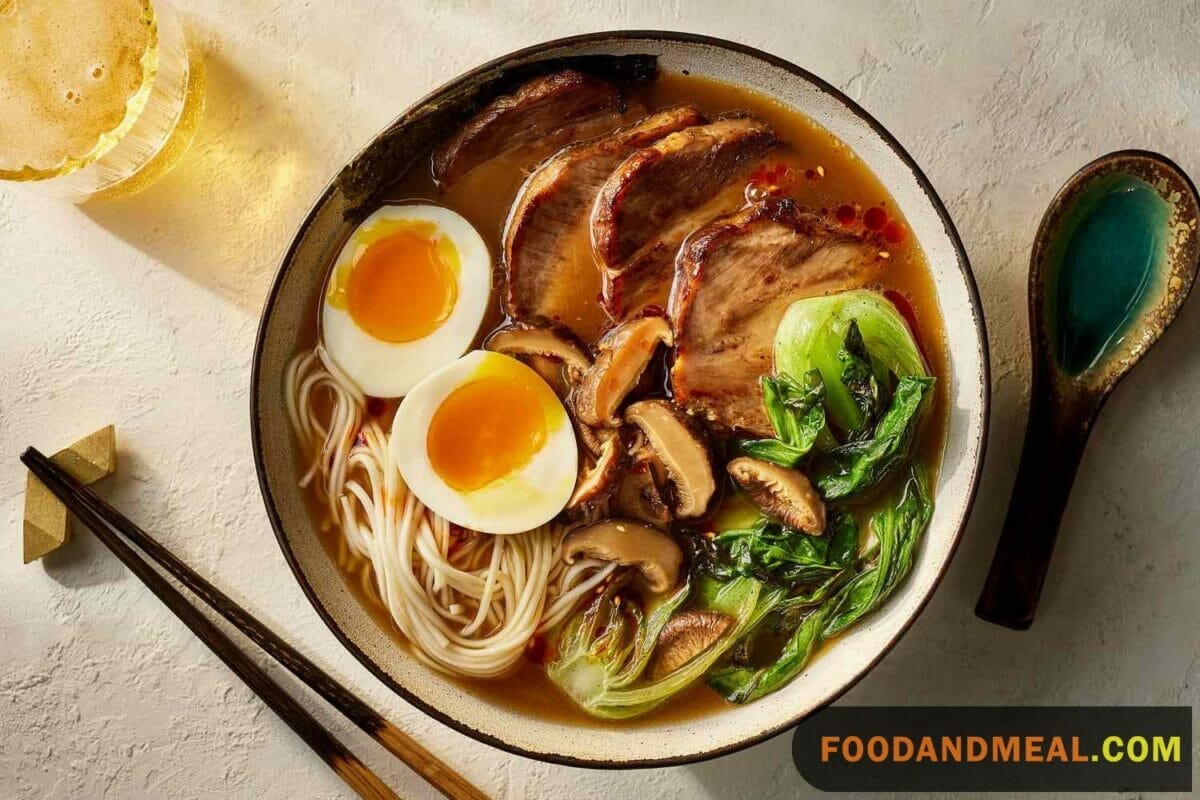
Cooking Tips
- Start with a good quality broth. Use a combination of chicken, pork, and vegetable broths for maximum flavor. Simmer the broth for several hours to extract the most flavor from the bones.
- Pay attention to the tare (seasoning sauce). The tare is what gives the ramen its distinct flavor profile. Make sure to use a good quality soy sauce and balance sweetness, saltiness and savoriness.
- Don’t overlook the aromatics. Scallions, garlic, ginger and sesame oil are all essential for infusing aroma into the broth. Char the aromatics first to amp up the flavor.
- Cook the noodles properly. Undercooked noodles will be gummy while overcooked noodles turn to mush. Follow the package directions and test a noodle for doneness.
- Top it off with tasty toppings. Soft boiled eggs, roasted pork belly, bamboo shoots, seaweed and scallions all make great additions. Play around with different textures and flavors.
- Have patience. Making ramen broth can take 8 hours or longer. Rushing the process compromises quality. Take your time to let the flavors properly meld.
- Adjust seasoning carefully. Only add salt, acid or other seasonings in small increments. You can always add more, but you can’t take it out!
Serving Suggestions
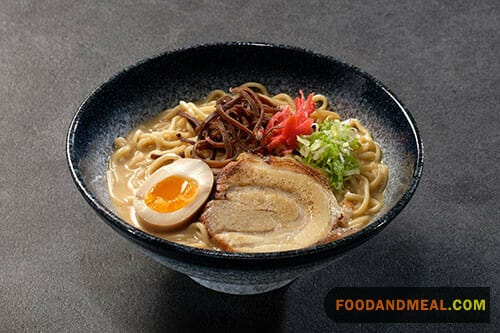
Shoyu Tonkotsu Ramen would pair nicely with some classic Japanese gyoza dumplings on the side. The pan-fried pork potstickers offer a nice contrast in texture and flavor to the rich, savory ramen broth.
Some lightly pickled vegetables like daikon radish or cucumbers would also make a refreshing accompaniment. The tanginess helps cut through the unctuous broth.
For drinks, I’d suggest some hot green tea, cold beer, or even sake to complement this umami-packed ramen. A crisp Japanese lager or a fragrant ginjo sake allow the complex flavors of the broth and noodles to shine.
You could also add some classic ramen toppings to customize your bowl. Slow-cooked chashu pork, marinated soft boiled eggs, sweet corn kernels, and shredded nori seaweed are some popular options. They provide little bursts of flavor and texture with each bite.
FAQs about Shoyu Tonkotsu Ramen
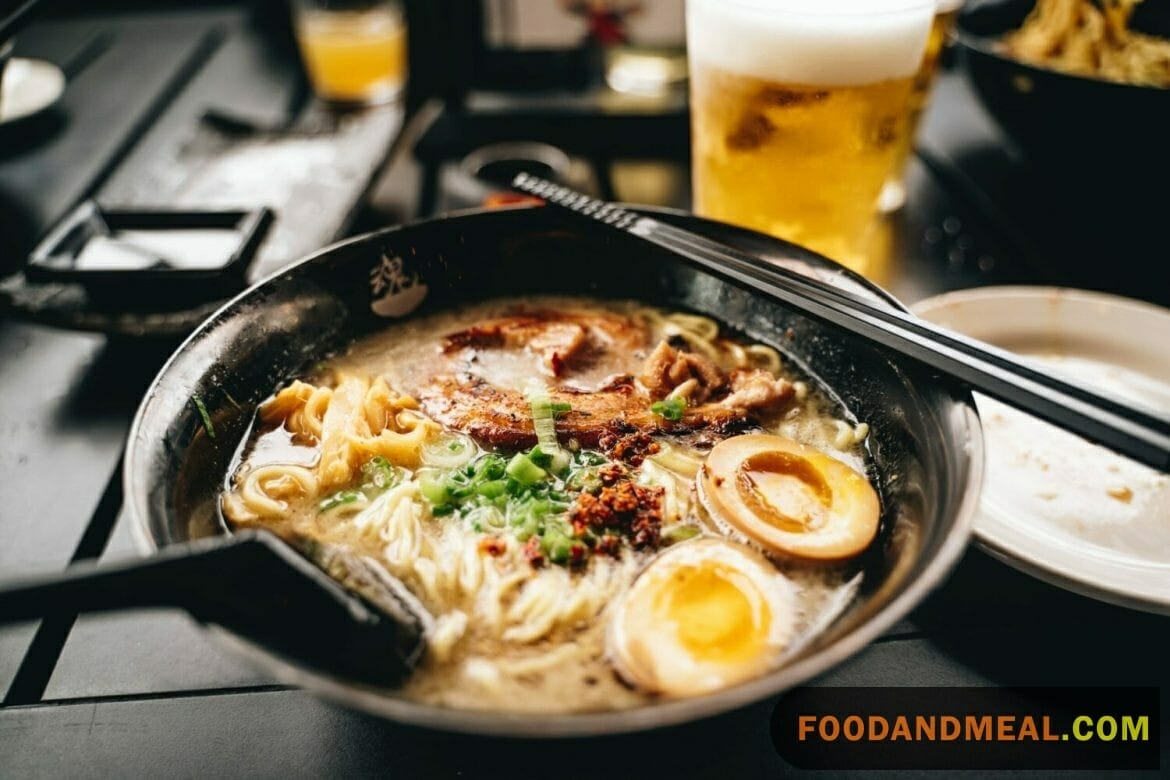
- What is Shoyu Tonkotsu Ramen, and what makes it special? Shoyu Tonkotsu Ramen is a Japanese noodle soup known for its rich and savory broth. It combines the deep umami flavors of pork bone broth with the delightful tang of soy sauce (shoyu). What sets it apart is the harmonious balance of flavors that tantalize your taste buds.
- Can I make Shoyu Tonkotsu Ramen vegetarian or vegan? Absolutely! While the traditional recipe uses pork-based broth, you can easily adapt it to your dietary preferences. Replace the pork broth with a vegetable or mushroom-based broth, and substitute pork toppings with tofu or other plant-based options.
- How long does it take to make Shoyu Tonkotsu Ramen from scratch? Preparing Shoyu Tonkotsu Ramen from scratch can be a labor of love. It typically takes around 8-10 hours, primarily due to the slow-cooking process required to create the rich and creamy pork bone broth. However, the result is well worth the effort.
- Can I store leftover Shoyu Tonkotsu Ramen broth and noodles? Yes, you can! Store leftover broth in an airtight container in the refrigerator for up to 3-4 days. Noodles, on the other hand, are best enjoyed fresh and are not ideal for storing. Reheat the broth separately and prepare fresh noodles when serving leftovers.
- What are some popular side dishes to enjoy with Shoyu Tonkotsu Ramen? Shoyu Tonkotsu Ramen pairs wonderfully with a variety of sides. Some popular choices include gyoza (dumplings), edamame, Japanese pickles (tsukemono), and seaweed salad. Experiment with different combinations to find your perfect ramen accompaniment.
- What is the difference between tonkotsu and shoyu ramen? Tonkotsu ramen features a rich and hearty broth made from simmering pork bones, resulting in a creamy and flavorful soup. On the other hand, shoyu ramen uses a soy sauce-based broth that is savory and slightly salty.
- What flavor is tonkotsu ramen? Tonkotsu ramen has a pork-based broth that is rich, creamy, and often described as hearty. The broth is the key element, providing a savory and satisfying flavor profile.
- Is shio or shoyu ramen better? The preference between shio (salt) and shoyu (soy sauce) ramen is subjective. Shio ramen has a lighter and cleaner taste due to its salt-based broth, while shoyu ramen has a bolder flavor with the soy sauce enhancing the savory profile. It ultimately depends on personal taste preferences.
- What are the 4 main types of ramen? The four main types of ramen are: Shoyu Ramen, Shio Ramen, Miso Ramen and Tonkotsu Ramen
Conclution
As I slurped up the last few noodles from my bowl, I felt a sense of pride and accomplishment. Sure, my first attempt at homemade ramen wasn’t perfect. But it filled my kitchen with enticing aromas and warmed me from the inside out.
Making the Shoyu Tonkotsu Ramen took effort and patience. Yet the final product was so rewarding. With each sip of the savory broth, I was reminded of the joy of cooking. And how even a simple bowl of noodles can lift your spirits.
I can’t wait to try more ramen recipes and variations. Though I’ll always have a soft spot for this one – my first-ever homemade bowl. It pulled me out of my winter funk and opened up a whole new world of ramen possibilities.
I’m thankful to Food And Meal for inspiring me to venture into homemade ramen. Posting my experience on their website encouraged me to fully dive in and not be intimidated. Now I feel confident to experiment with more recipes from their site, building my ramen repertoire over time.
Who knows, maybe I’ll start my own ramen blog one day! For now, I’m just happy to have discovered this comforting, flavorful dish. A new favorite that I’ll be returning to any time I need a pick-me-up.
I'm James F Anderson, a noted sous chef from London and a Le Cordon Bleu alumnus. My career began in a Michelin-starred Parisian eatery, where my blend of classic and contemporary cooking, using seasonal ingredients, earned accolades. Recognized in culinary publications and on cooking shows, I’m committed to mentoring aspiring chefs and delivering memorable dining experiences, marking me as a standout talent in the culinary world.




